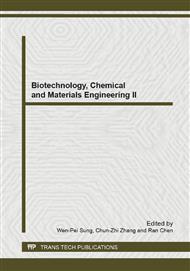[1]
R. Grantham, C. Gautier, M. Gouy, R. Mercier and A. Pave: Nucleic Acids Research Vol. 8 (1980), pp.49-62.
Google Scholar
[2]
P.M. Sharp, E. Cowe and D.G. Higgins: Nucleic Acids Research Vol. 16 (1988), pp.8207-8211.
Google Scholar
[3]
A. Fuglsang: Apmis Vol. 111 (2003), pp.843-847.
Google Scholar
[4]
Q. Liu, S. Dou, Z. Ji and Q. Xue: Biosystems Vol. 80 (2005), pp.123-131.
Google Scholar
[5]
J.M. Ma, T. Zhou, W.J. Gu, X. Sun and Z.H. Lu: Biosystems Vol. 65 (2002), pp.199-207.
Google Scholar
[6]
J. Ma, M.N. Nguyen and J.C. Rajapakse: IEEE/ACM Transaction, Computational Biology Bioinformatics Vol. 6 (2009), pp.134-143.
Google Scholar
[7]
G. Marais and L. Duret: Journal of Molecular Evolution Vol. 52 (2001), pp.275-280.
Google Scholar
[8]
H. Miyasaka: Journal of Molecular Evolution Vol. 55 (2002), pp.52-64.
Google Scholar
[9]
V. Scaiewicz, V. Sabbia, R. Piovani and H. Musto: Biochemical and Biophysical Research Communications Vol. 343 (2006), pp.1257-1261.
DOI: 10.1016/j.bbrc.2006.03.108
Google Scholar
[10]
P.C. Woo, B.H. Wong, Y. Huang, S.K. Lau and K.Y. Yuen: Virology Vol. 369 (2007), pp.431-442.
Google Scholar
[11]
J. Ma, A. Campbell and S. Karlin: Journal of bacteriology Vol. 184 (2002), pp.5733-5745.
Google Scholar
[12]
A.W. Carrie, S. Yu and H. Johannesson: Genome Biology and Evolution Vol. 3 (2011), pp.332-343.
Google Scholar
[13]
J.M. Comeron: Genetics Vol. 167 (2004), pp.1293-1304.
Google Scholar
[14]
S. Noboru: Journal of Molecular Evolution, Spinger, New York Vol. 49 (1999), pp.49-62.
Google Scholar
[15]
W. Gu, T. Zhou, J. Ma, X. Sun and Z. Lu: Biosystems Vol. 73 (2004), pp.89-97.
Google Scholar
[16]
B. Kahali, S. Basak, T.C. Ghosh: Biochemical and Biophysical Research Communications Vol. 354 (2007), pp.693-699.
Google Scholar
[17]
L. Duret: Trends in Genetics Vol. 16 (2000), pp.287-289.
Google Scholar
[18]
S. Noguchi and Y. Satow: Journal of Biochemistry, Oxford University Press, New York Vol. 140 (2006), pp.799-804.
Google Scholar
[19]
K. Sau, S.K. Gupta, S. Sau and T.C. Ghosh: Virus Research, Elsevier Ltd, Oxford Vol. 113 (2005), pp.123-231.
Google Scholar
[20]
N. Sueoka and Y. Kawanishi: Gene, Elsevier Ltd, Oxford Vol. 26 (2000), pp.53-62.
Google Scholar
[21]
X.F. Wan, D. Xu, A. Kleinhofs and J.Z. Zhou: BMC Evolutionary Biology, BioMed Central Ltd, England and Wales Vol. 4 (2004), p.19.
Google Scholar
[22]
R. Versteeg, B.D. van Schaik, M.F. Van Batenburg, M. Roos, R. Monajemi, H. Caron, H.J. Bussemaker and A.H. van Kampen: Genome Res Vol. 13 (2003), p.1998-(2004).
DOI: 10.1101/gr.1649303
Google Scholar
[23]
K. Sau and A. Deb: In Silico Biology Vol. 9 (2008), pp.1-9.
Google Scholar
[24]
W.J. Gu, T. Zhou, J.M. Ma, X. Sun and Z.H. Lu: Biosystems Vol. 73 (2004), pp.89-97.
Google Scholar
[25]
H. Grosjean and W. Fiers: Gene Vol. 18 (1982), pp.199-209.
Google Scholar
[26]
G. Liu, J. Wu, H. Yang and Q. Bao: Comparative and functional genomics Vol. 2010 (2010), pp.343-569.
Google Scholar
[27]
H. Gingold and Y. Pilpel: Molecular systems biology Vol. 12 (2011), p.481.
Google Scholar
[28]
G.A. Palidwor, T.J. Perkins and X. Xia: PLoS One Vol. 5 (2010), p. e13431.
Google Scholar
[29]
J.B. Plotkin and G. Kudla: Nature Reviews Genetics Vol. 12 (2010), pp.32-42.
Google Scholar
[30]
P.M. Sharp, L.R. Emery and K. Zeng: Philosophical Transactions of the royal society B, Biological Sciences Vol. 365 (2010), pp.1203-1212.
Google Scholar
[31]
X.R. Ma, S.B. Xiao, L.R. Fang, et al: Yi Chuan Xue Bao Vol. 32 (2005), pp.616-624.
Google Scholar
[32]
M. Botzman and H. Margalit: Genome Biology Vol. 12 (2011), p. R109.
Google Scholar
[33]
Y.M. Saif: Diseases of Poultry (Blackwell Publishing, Ames, Iowa 2008).
Google Scholar
[34]
X.Y. Yang, X.F. Qi, A.C. Cheng, M.S. Wang, D.K. Zhu, R.Y. Jia and X.Y. Chen: The Veterinary Journal Vol. 185 (2010), pp.199-203.
Google Scholar
[35]
A.C. Cheng, M.S. Wang, M. Wen, W.G. Zhou, Y.F. Guo, R.Y. Jia, C. XU, G.P. Yuan and Y.C. Liu: High. Technol. Lett Vol. 16 (2006), pp.948-953.
Google Scholar
[36]
L.C. Zhao, A.C. Cheng, M.S. Wang, G. P. Yuan and M. S. Cai: Prog Nat Sci Vol. 18 (2008), pp.1069-1076.
Google Scholar
[37]
H. Chang, A.C. Cheng, M.S. Wang, X. Wei, K. P. Lou, M. S. Cai, et al: IEEE, the 2nd International Conference on BioMedical Engineering and Informatics Vol. 4 (2009), pp.1836-1841/1874.
Google Scholar
[38]
Y. Zhang, A.C. Cheng, M.S. Wang, D.K. Zhu, R.Y. Jia, F. Liu, et al: IEEE, the 2nd International Conference on BioMedical Engineering and Informatics Vol. 4 (2009), pp.1829-1835.
Google Scholar
[39]
S.C. Zhang, A.C. Cheng and M.S. Wang: IEEE, The 4th International Conference on Bioinformatics and Biomedical Engineering (2010), pp.1-9.
Google Scholar
[40]
M.S. Cai, A.C. Cheng and M.S. Wang: Intervirology Vol. 52 (2009), pp.266-278.
Google Scholar
[41]
Q. He, A.C. Cheng and M.S. Wang: Information Technology and Agricultural Engineering Vol. 134 (2012), pp.747-760.
Google Scholar
[42]
R.Y. Jia, A.C. Cheng and M.S. Wang: Virus Genes Vol. 38 (2009), pp.96-103.
Google Scholar
[43]
F.J. Li, A.C. Cheng and M.S. Wang: Advanced Materials Reserch Vol. 424-425 (2012), pp.680-689.
Google Scholar
[44]
X.X. Hu, A.C. Cheng, M.S. Wang: Advanced Materials Reserch Vol. 393-395 (2011), pp.641-650.
Google Scholar
[45]
F. Wright: Gene Vol. 87 (1990), pp.23-29.
Google Scholar
[46]
H. Lu, W.M. Zhao, Y. Zheng, H. Wang, M. Qi and X. P. Yu: Acta Biochimica et Biophysica Sinica, Shanghai inst biochemistry, academia sinica, Shanghai Vol. 37 (2005), pp.1-10.
Google Scholar
[47]
J.A. Novembre: Molecular Biology and Evolution, Oxford University Press, Oxford Vol. 19 (2002), pp.1390-1394.
Google Scholar
[48]
H.S. Najafabadi, J. Lehmann and M. Omidi: Gene, Elsevier Science, Amsterdam Vol. 387 (2007), pp.150-155.
Google Scholar
[49]
H. Sakai, T. Washio, R. Saito et al: Gene Vol. 276 (2001), pp.101-105.
Google Scholar
[50]
J. Lobry and C. Gautier: Nucleic Acids Research Vol. 22 (1994), pp.3174-3180.
Google Scholar


